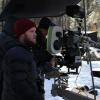I looked into renting the 1.33x V-Lite Hawks for a 3-perf S35 production I shot last November so I could get 2.40 without having to do an extraction, but still save on stock. I found it to be not worth the hassle or expense. With the ubiquity of similarly sized digital sensors and the popularity of anamorphic these days, you'd think they'd be readily available in LA, but that's not the case. So I contacted Vantage in Weiden, and they were willing to rent them to me, but they would've had to be shipped from Germany, with a customs broker at LAX, all totaling over $2000 just for shipping, not including rental cost.
Locally, I was only able to locate the S16 lenses. As far as I know, the image circle on that set will not cover a S35 sensor or gate. It's two different sets of lenses. If you look at Keslow's catalog, they only carry the focal range from 14mm to 35mm, which makes sense for S16 but not for S35. From what I read in F&D Times, the V-Lite spherical components, and therefore focal lengths, are the same across the S35s but the two different anamorphots are changeable, or something along those lines.
It's a bummer, because I think these lenses are extraordinarily useful and they'd be flying off rental shelves if they were more available. I was again hoping to use them on an Alexa Open Gate to get a perfect 2.0:1, providing they covered the sensor.
So many possibilities, and a really unique look.




